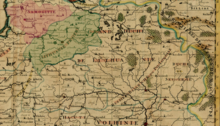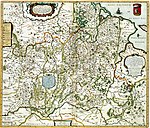
Back Літва (зямля) Byelorussian Літва BE-X-OLD Lituània pròpia Catalan Det egentlige Litauen Danish Lituania propia Spanish Lituania Propria ID Lithuania Propria Italian Didžioji Lietuva Lithuanian Eigentlege Litauen NN Litwa właściwa Polish

| History of Lithuania |
|---|
 |
| Chronology |
|
|
Lithuania proper (Latin: Lithuania propria;[1][2] Lithuanian: Tikroji Lietuva, Didžioji Lietuva[1][3])[a] refers to a region that existed within the Grand Duchy of Lithuania where the Lithuanian language was spoken.[4] The primary meaning is identical to the Duchy of Lithuania, a land around which the Grand Duchy of Lithuania evolved. The territory can be traced by Catholic Christian parishes established in pagan Baltic lands of the Grand Duchy of Lithuania subsequent to the Christianization of Lithuania in 1387. Lithuania proper (Lithuania Propria) was always distinguished from the Ruthenian lands since the Lithuanians differed from the Ruthenians in their language and faith (Paganism in the beginning and Catholicism since 1387).[5][6][7] The term in Latin was widely used during the Middle Ages and can be found in numerous historical maps until World War I.
Lithuania proper is sometimes also called Lithuania Major, particularly in contrast with Lithuania Minor.
The Lithuanian geographer Kazys Pakštas wrote that Lithuania proper was known since the administrative division of the Grand Duchy of Lithuania in 1566, when the name was assigned to the palatinates of Vilnius and Trakai.[1] The name was used in documents and maps.[1] Lithuania proper also included the Duchy of Samogitia.[1]
- ^ a b c d e Gimžauskas 2001, p. 108.
- ^ Frost 2015, p. 67.
- ^ Spečiūnas, Vytautas. "Didžioji Lietuva [Greater Lithuania]". Visuotinė lietuvių enciklopedija.
- ^ Stone 2014, p. 4.
- ^ "Legacy of Medieval Lithuania". Retrieved 26 September 2020.
- ^ Gaučas 1986, p. 195-196.
- ^ Safarewicz 1967, p. 257-259.
© MMXXIII Rich X Search. We shall prevail. All rights reserved. Rich X Search